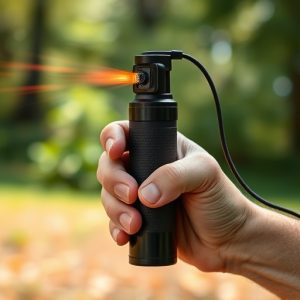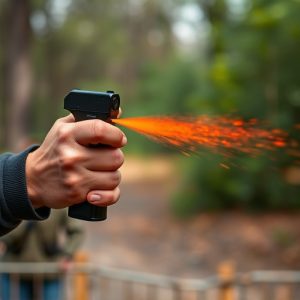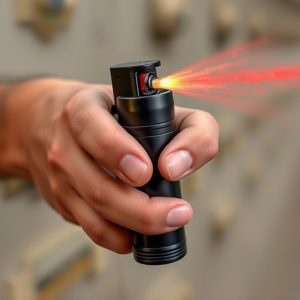Pepper Spray Crowd Control: Legal Concentrations & Effective Strategies
Pepper spray, with its highest legal capsaicin concentration (2-5 million SHU), is a globally used l…….
Pepper spray, with its highest legal capsaicin concentration (2-5 million SHU), is a globally used law enforcement tool for crowd control. Its effectiveness in inducing pain and disabling vision/breathing temporarily makes it a non-lethal option for maintaining public order, but deployment must adhere to strict guidelines and local regulations. Choosing the strongest legal pepper spray concentration involves balancing potency (measured in mg/ml) with safety, considering factors like intended use scenario and crowd behavior. Responsible use requires proper training, protective gear, and strategic implementation, alongside regular simulations and careful consideration of environmental conditions, to maximize positive outcomes while minimizing harm.
“In situations requiring crowd control, law enforcement agencies often turn to pepper spray as a tactical tool. This article explores the multifaceted use of pepper spray by police, delving into its effectiveness and the legal framework that governs its application. We examine the crucial factor of choosing the strongest legal pepper spray concentration, while also highlighting safety precautions essential for crowded events. Through case studies, we analyze successful and unsuccessful deployments, offering insights into best practices for effective crowd management with this potent tool.”
- Understanding Pepper Spray as a Crowd Control Measure
- Legal Framework and Regulations for Police Use of Pepper Spray
- Key Considerations in Choosing the Strongest Legal Pepper Spray Concentration
- Effective Implementation and Safety Precautions During Crowded Events
- Case Studies: Successful and Unsuccessful Deployments of Pepper Spray
Understanding Pepper Spray as a Crowd Control Measure
Pepper spray, officially known as oleoresin capsicum (OC) spray, is a powerful crowd control tool utilized by law enforcement agencies worldwide. Its primary function is to temporarily disable individuals and disperse crowds through a unique chemical reaction with the body’s nerve endings. When deployed, pepper spray creates a burning sensation, leading to tears, coughing, and temporary blindness, making it an effective measure for controlling aggressive or unruly groups.
The effectiveness of pepper spray lies in its strongest legal concentration, typically measured in capsaicin units (CU). The most potent varieties can range from 2 million to 5 million SHU (Scoville Heat Units), ensuring a swift and powerful response. This concentrated solution is contained within specialized canisters, allowing officers to quickly deploy it in various crowd control scenarios, making it a critical component of modern policing strategies.
Legal Framework and Regulations for Police Use of Pepper Spray
The legal framework governing police use of pepper spray varies significantly across jurisdictions, but common threads include ensuring proportionate force and adherence to strict guidelines for crowd control. In many countries, police forces are permitted to employ pepper spray as a non-lethal option for subduing agitated or violent individuals and dispersing crowds. However, the regulations around its use are designed to protect both public safety and civil liberties. Key among these is the regulation of the strongest legal pepper spray concentration, which is typically capped at levels that still allow for safe dispersal while minimizing risk of severe injury.
Officers must receive specialized training in the deployment of pepper spray, including when it’s appropriate to use, how to administer it effectively, and the de-escalation techniques required before resorting to such force. This training ensures that police can make informed decisions about whether and when to deploy pepper spray, balancing public order maintenance with the need to minimize harm. Regulations also dictate storage, handling, and disposal protocols for pepper spray, further emphasizing responsible use and minimizing potential risks to both officers and civilians.
Key Considerations in Choosing the Strongest Legal Pepper Spray Concentration
When selecting pepper spray for crowd control, understanding and adhering to legal guidelines is paramount. The strongest legal pepper spray concentration should be considered based on several key factors. First, local laws vary significantly regarding acceptable concentrations; thus, it’s crucial to consult legislation specific to your jurisdiction. Pepper sprays are typically labeled with their capsaicin content, measured in milligrams per milliliter (mg/ml), which indicates potency. Higher mg/ml values signify stronger effects, but they must fall within legal boundaries.
Additionally, the intended use and the nature of the crowds you’ll be dealing with play a role. For example, in high-risk situations involving violent individuals or large, unruly gatherings, a more potent spray might be justified to ensure public safety. However, less concentrated varieties may suffice for general crowd management scenarios, balancing effectiveness with minimal risk of causing harm to bystanders or officers.
Effective Implementation and Safety Precautions During Crowded Events
When implementing pepper spray for crowd control during crowded events, it’s crucial to balance effectiveness with safety precautions. Law enforcement agencies should prioritize using the strongest legal pepper spray concentration approved for public safety to ensure swift and efficient dispersal of crowds. This powerful tool disrupts visual acuity, respiratory function, and general disorientation, allowing for rapid control of potentially volatile situations.
However, proper training and safety protocols are paramount. Officers must be equipped with adequate personal protective equipment (PPE), including eye protection and respirators, to safeguard themselves from accidental exposure. Additionally, clear communication strategies should be in place to instruct crowd members about the dangers of pepper spray and alternative routes or assembly points. Regular simulations and exercises help prepare officers for real-world scenarios, ensuring they use pepper spray judiciously and responsibly while minimizing harm to both public safety and their own well-being.
Case Studies: Successful and Unsuccessful Deployments of Pepper Spray
In evaluating the use of pepper spray for crowd control, case studies offer valuable insights into both its potential and pitfalls. Successful deployments highlight its effectiveness in de-escalating volatile situations and controlling large gatherings with minimal harm. For instance, in high-density urban settings, law enforcement agencies have employed strongest legal pepper spray concentration to disrupt violent protests, ensuring officer safety while managing crowd dispersion efficiently. These positive outcomes underscore the strategic use of pepper spray as a non-lethal force option.
Conversely, unsuccessful deployments often arise from improper usage or unsuitable conditions. In some cases, inadequate training has led to misapplication, causing unnecessary injuries among both protesters and bystanders. Additionally, environmental factors such as high winds or humid conditions can diminish the spray’s effectiveness, making it less reliable in specific scenarios. Case studies of these failures underscore the importance of thorough preparation, including regular training, suitable weather conditions, and careful consideration of crowd dynamics to maximize the positive impact and minimize potential harm associated with pepper spray use.
In conclusion, while pepper spray can be an effective crowd control tool, its use must be carefully regulated and implemented. Understanding the legal framework, considering the strongest legal pepper spray concentration, and adhering to safety precautions are crucial for both efficient event management and public safety. Case studies highlight the importance of strategic deployment, demonstrating that successful uses can de-escalate situations swiftly, while unsuccessful deployments may lead to adverse outcomes. By learning from these scenarios, law enforcement can enhance their crowd control strategies, ensuring a balance between security and the well-being of those present at crowded events.


